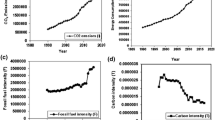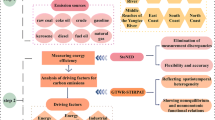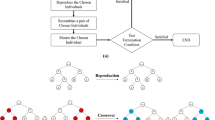Abstract
Using the extended STIRPAT model, this research examines the influence of various factors on China carbon emission from 1971 to 2014, including total nuclear and alternative energy, total fossil energy, GDP per capita, total population, total urban population, merchandise trade of GDP, and services value added of GDP. Ridge regression was employed to perform the study. The research results show the positivity and significance of all factors on carbon emission. The estimated elastic coefficients reveal the most important factor influencing carbon emission is GDP per capita. Total fossil energy, total urban population, and nuclear energy of total energy use are also prominent influencing factors, while other factors such as value-added services of GDP and merchandise trade of GDP have less significant impacts on carbon emission in China. These findings of the research will be of great significance for China to control its carbon emission in the future and to mitigate global warming to some extent.



Similar content being viewed by others
References
Ahmad M, Zhao ZY, Li H (2019) Revealing stylized empirical interactions among construction sector, urbanization, energy consumption, economic growth and CO2 emissions in China. Sci Total Environ 657:1085–1098
Antonakakis N, Chatziantoniou I, Filis G (2017) Energy consumption, CO 2, emissions, and economic growth: an ethical dilemma. Renew Sustain Energy Rev 68(Part 1):808–824
Azizalrahman H, Hasyimi V (2019) A model for urban sector drivers of carbon emissions. Sustain Cities Soc 44:46–55
Bai Y, Deng X, Gibson J, Zhao Z, Xu H (2019) How does urbanization affect residential CO2 emissions? An analysis on urban agglomerations of China. J Clean Prod 209:876–885
Chang M, Zheng J, Inoue Y, Tian X, Chen Q, Gan T (2018) Comparative analysis on the socioeconomic drivers of industrial air-pollutant emissions between Japan and China: insights for the further-abatement period based on the LMDI method. J Clean Prod 189:240–250
Chen Y, Lin S (2015) Decomposition and allocation of energy-related carbon dioxide emission allowance over provinces of China. Nat Hazards 76(3):1893–1909
Chertow MR (2010) The IPAT equation and its variants. J Ind Ecol 4(4):13–29
Climate Change (2007) Working group, I: the physical science basis. IPCC, Geneva, p 2007
Climate Change (2013) The physical science basis, IPCC fifth assessment report WGI AR5.2013
Dietz T, Rosa EA (1997) Effects of population and affluence on CO2 emissions. Proc Natl Acad Sci U S A 94:175–179
Dietz T, Rosa EA (2002) Bridging environmental science with environmental policy: plasticity of population, affluence, and technology. Soc Sci Q 83(1):18–34
Gill AR, Viswanathan KK, Hassan S (2018) A test of environmental Kuznets curve (EKC) for carbon emission and potential of renewable energy to reduce green house gases (GHG) in Malaysia. Environ Dev Sustain (2):1–12
Gokmenoglu KK, Taspinar N (2018) Testing the agriculture-induced EKC hypothesis: the case of Pakistan. Environ Sci Pollut Res:1–13
Hoerl AE, Kennard RW (1970) Ridge regression: applications to nonorthogonal problems. Technometrics 12(1):69–82
Hoerl AE, Kannard RW, Baldwin KF (1975) Ridge regression: some simulations. Communications in Statistics 4(2):105–123
Hoesly R, Matthews HS, Hendrickson C (2015) Energy and emissions from U.S. population shifts and implications for regional GHG mitigation planning. Environ Sci Technol 49(21):12670–12678
Hubacek K, Feng K, Chen B (2011) Changing lifestyles towards a low carbon economy: an IPAT analysis for China. Energies 5(1):22–31
Hughes TP, Kerry JT, Baird AH, Connolly SR, Dietzel A, Eakin CM, Heron SF, Hoey AS, Hoogenboom MO, Liu G, McWilliam MJ, Pears RJ, Pratchett MS, Skirving WJ, Stella JS, Torda G (2018) Global warming transforms coral reef assemblages. Nature 556(7702):492–496
Khan AQ, Saleem N, Fatima ST (2018) Financial development, income inequality, and CO2 emissions in Asian countries using STIRPAT model. Environ Sci Pollut Res Int 25(7):1–12
Li S, Wang S (2019) Examining the effects of socioeconomic development on China’s carbon productivity: a panel data analysis. Sci Total Environ 659:681–690
Li YN, Cai M, Wu K, Wei J (2019) Decoupling analysis of carbon emission from construction land in Shanghai. J Clean Prod 210:25–34
Liang Y, Niu D, Wang H, Li Y (2017) Factors affecting transportation sector CO2 emissions growth in China: an LMDI decomposition analysis. Sustainability 9(10):1730
Liu D, Guo X, Xiao B (2019a) What causes growth of global greenhouse gas emissions? Evidence from 40 countries. Sci Total Environ 661:750–766
Liu S, Fan F, Zhang J (2019b) Are small cities more environmentally friendly? An empirical study from China. Int J Environ Res Public Health 16:727
Lu Y, Cui P, Li D (2017) Which activities contribute most to building energy consumption in China? A hybrid LMDI decomposition analysis from year 2007 to 2015. Energ Build:165
Ma L, Chong C, Zhang X, Liu P, Li W, Li Z, Ni W (2018) LMDI decomposition of energy-related CO2 emissions based on energy and CO2 allocation Sankey diagrams: the method and an application to China. Sustainability 10(2):344
Marquardt D, Snee R (1975) Ridge regression in practice. Am Stat 29(1):3–20
Moutinho V, Madaleno M, Inglesi-Lotz R, Dogan E (2018) Factors affecting CO2 emissions in top countries on renewable energies: a LMDI decomposition application. Renew Sustain Energy Rev 90:605–622
Netherlands Environmental Assessment Agency (2015) Data were from http://edgar.jrc.ec.europa.eu/overview.php?v=CO2ts_pc1990-2015
Panayotou T (1993) Empirical tests and policy analysis of environmental degradation at different stages of economic development. International Labor office, Technology and Employment Programme, Geneva. Working Papers
Piłatowska M, Włodarczyk A (2018) Decoupling economic growth from carbon dioxide emissions in the EU countries. Montenegrin Journal of Economics 14:7–26
Roy M, Basu S, Pal P (2017) Examining the driving forces in moving toward a low carbon society: an extended STIRPAT analysis for a fast growing vast economy. Clean Techn Environ Policy 19(9):2265–2276
Sarkodie SA (2018) The invisible hand and EKC hypothesis: what are the drivers of environmental degradation and pollution in Africa? Environ Sci Pollut Res 11:1–30
Shahbaz M, Loganathan N, Muzaffar AT, Ahmed K, Ali Jabran M (2016) How urbanization affects CO 2, emissions in Malaysia? The application of STIRPAT model. Renew Sustain Energy Rev 57:83–93
Shahbaz M, Chaudhary AR, Ozturk I (2017) Does urbanization cause increasing energy demand in Pakistan? Empirical evidence from STIRPAT model. Energy 122:83–93
Shi L, Sun J, Lin J, Zhao Y (2019) Factor decomposition of carbon emissions in Chinese megacities. J Environ Sci 75:209–215
Tang X, Jin Y, Wang X, Wang J, McLellan BC (2017) Will China’s trade restructuring reduce CO 2 emissions embodied in international exports? J Clean Prod 161:1094–1103
Ulucak R, Bilgili F (2018) A reinvestigation of EKC model by ecological footprint measurement for high, middle and low income countries. J Clean Prod 188:144–157
Wang Q, Yang X (2019) Urbanization impact on residential energy consumption in China: the roles of income, urbanization level, and urban density. Environ Sci Pollut Res Int 26:3542–3555
Wang P, Wu W, Zhu B, Wei Y (2013) Examining the impact factors of energy-related CO 2, emissions using the STIRPAT model in Guangdong Province, China. Appl Energy 106(11):65–71
Wang C, Wang F, Zhang X, Yang Y, Su Y, Ye Y, Zhang H (2017) Examining the driving factors of energy related carbon emissions using the extended STIRPAT model based on IPAT identity in Xinjiang. Renew Sustain Energy Rev 67:51–61
Wang Y, Yang G, Dong Y et al (2018) The scale, structure and influencing factors of total carbon emissions from households in 30 provinces of China—based on the extended STIRPAT model. Energies:11
World Bank (2018) website https://data.worldbank.org/indicator
Xiao H, Sun KJ, Bi HM, Xue JJ (2019) Changes in carbon intensity globally and in countries: attribution and decomposition analysis. Appl Energy 235:1492–1504
Xu X, Mu M, Wang Q (2017) Recalculating CO 2 emissions from the perspective of value-added trade: an input-output analysis of China’s trade data. Energy Policy 107:158–166
Xu SC, Miao Y-M, Gao C, Long RY, Chen H, Zhao B, Wang SX (2019) Regional differences in impacts of economic growth and urbanization on air pollutants in China based on provincial panel estimation. J Clean Prod 208:340–352
Yang L, Lin B (2016) Carbon dioxide-emission in China’s power industry: evidence and policy implications. Renew Sustain Energy Rev 60:258–267
Yang L, Xia H, Zhang X, Yuan S (2018) What matters for carbon emissions in regional sectors? A China study of extended STIRPAT model. J Clean Prod 180:595–602
York R, Rosa EA, Dietz T (2015) STIRPAT, IPAT and ImPACT. Ecol Econ 46(3):351–365
Zhang P, He J, Hong X, Zhang W, Qin C, Pang B, Li Y, Liu Y (2017) Regional-level carbon emissions modelling and scenario analysis: a STIRPAT case study in Henan Province, China. Sustainability 9(12):2342
Zhang H, Zhu Z, Fan Y (2018) The impact of environmental regulation on the coordinated development of environment and economy in China. Nat Hazards 91(3):1–17
Zhao S, Liao J, Yu D (2018a) Model averaging estimator in ridge regression and its large sample properties. Stat Pap (4):1–21
Zhao Z, Bai Y, Wang G, Chen J, Yu J, Liu W (2018b) Land eco-efficiency for new-type urbanization in the Beijing-Tianjin-Hebei region. Technol Forecast Soc Chang 137:19–26
Author information
Authors and Affiliations
Corresponding author
Additional information
Responsible editor: Muhammad Shahbaz
Publisher’s note
Springer Nature remains neutral with regard to jurisdictional claims in published maps and institutional affiliations.
Rights and permissions
About this article
Cite this article
Zhang, Y., Zhang, Q. & Pan, B. Impact of affluence and fossil energy on China carbon emissions using STIRPAT model. Environ Sci Pollut Res 26, 18814–18824 (2019). https://doi.org/10.1007/s11356-019-04950-4
Received:
Accepted:
Published:
Issue Date:
DOI: https://doi.org/10.1007/s11356-019-04950-4




